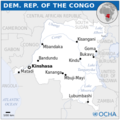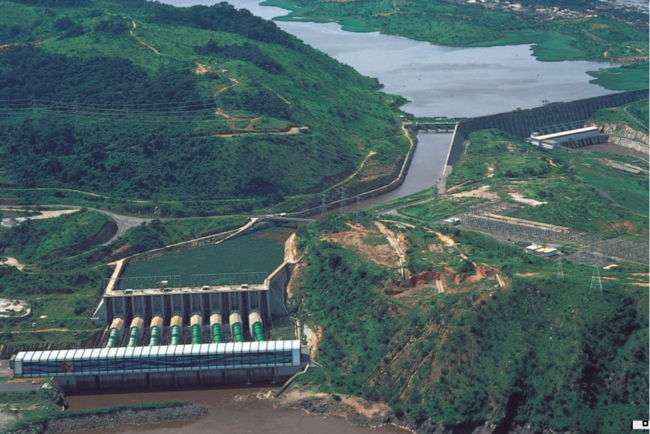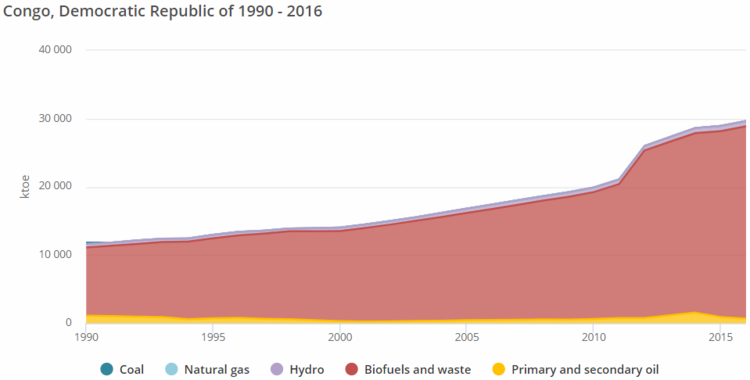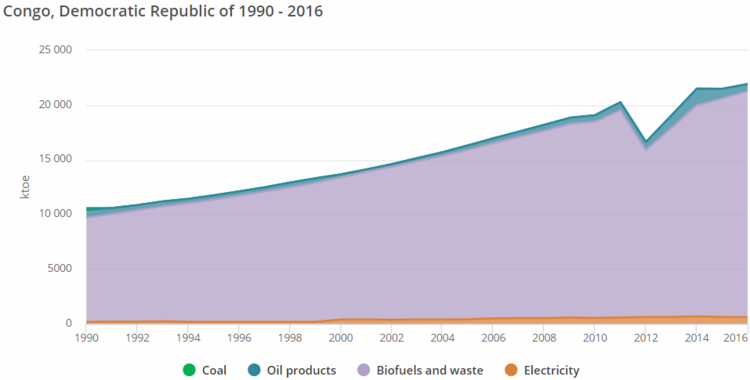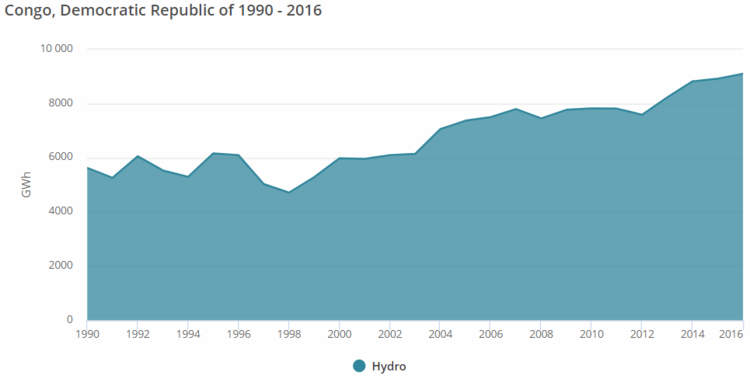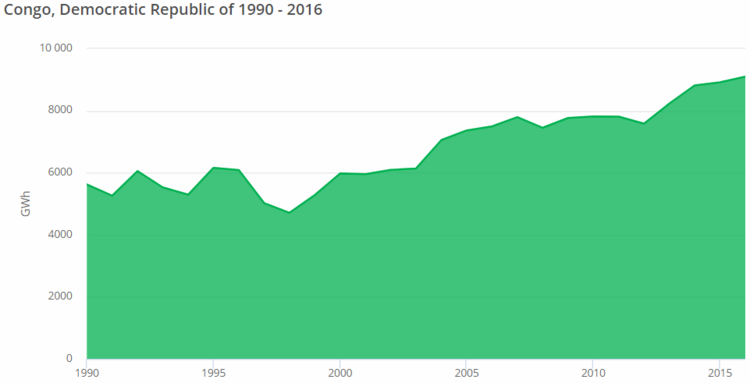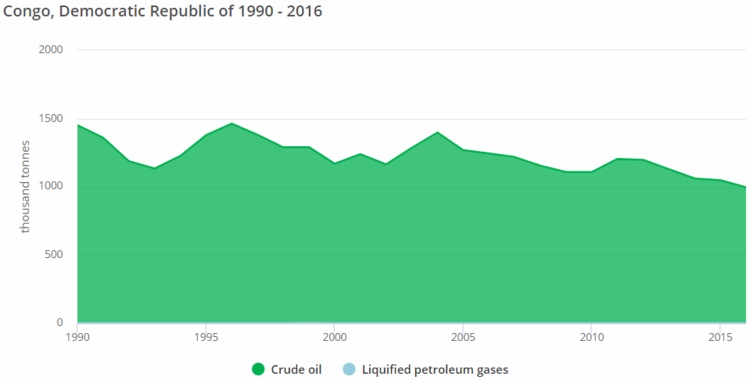Difference between revisions of "Democratic Republic of the Congo Energy Situation"
***** (***** | *****) |
***** (***** | *****) |
||
| Line 583: | Line 583: | ||
= Key Problems of the Energy Sector = | = Key Problems of the Energy Sector = | ||
| − | Even though the DRC possesses prosperous and varied resources for energy generation, the energy sector still falls far behind. This is due to the many problems, which the energy sector faces. In order to expand, improve and develop the country's energy sector, these challenges need to be mitigated and fixed. Some of these challenges are listed below<ref name="Bertule, M. Hansen, J.I. Karavai, M. Sandbukt, S. Staun, F. Wieben, E. & Lütken, S.E. (2013). Emissions Reduction Profile: Democratic Republic of Congo. Retrieved from: http://www.acp-cd4cdm.org/media/366216/emissions-reduction-profile-dr_congo.pdf">Bertule, M. Hansen, J.I. Karavai, M. Sandbukt, S. Staun, F. Wieben, E. & Lütken, S.E. (2013). Emissions Reduction Profile: Democratic Republic of Congo. Retrieved from: http://www.acp-cd4cdm.org/media/366216/emissions-reduction-profile-dr_congo.pdf</ref><ref name="Kusakana, K. (2016). A Review of Energy in the Democratic Republic of Congo. Retrieved from: https://www.researchgate.net/publication/306380971_A_Review_of_Energy_in_the_Democratic_Republic_of_Congo">Kusakana, K. (2016). A Review of Energy in the Democratic Republic of Congo. Retrieved from: https://www.researchgate.net/publication/306380971_A_Review_of_Energy_in_the_Democratic_Republic_of_Congo</ref>: | + | Even though the DRC possesses prosperous and varied resources for energy generation, the energy sector still falls far behind. This is due to the many problems, which the energy sector faces. In order to expand, improve and develop the country's energy sector, these challenges need to be mitigated and fixed. Some of these challenges are listed below<ref name="Bertule, M. Hansen, J.I. Karavai, M. Sandbukt, S. Staun, F. Wieben, E. & Lütken, S.E. (2013). Emissions Reduction Profile: Democratic Republic of Congo. Retrieved from: http://www.acp-cd4cdm.org/media/366216/emissions-reduction-profile-dr_congo.pdf">Bertule, M. Hansen, J.I. Karavai, M. Sandbukt, S. Staun, F. Wieben, E. & Lütken, S.E. (2013). Emissions Reduction Profile: Democratic Republic of Congo. Retrieved from: http://www.acp-cd4cdm.org/media/366216/emissions-reduction-profile-dr_congo.pdf</ref><ref name="Kusakana, K. (2016). A Review of Energy in the Democratic Republic of Congo. Retrieved from: https://www.researchgate.net/publication/306380971_A_Review_of_Energy_in_the_Democratic_Republic_of_Congo">Kusakana, K. (2016). A Review of Energy in the Democratic Republic of Congo. Retrieved from: https://www.researchgate.net/publication/306380971_A_Review_of_Energy_in_the_Democratic_Republic_of_Congo</ref><ref name="Power Africa. (2018). Democratic Republic of Congo Factsheet. Retrieved from: https://www.usaid.gov/sites/default/files/documents/1860/DRC-_November_2018_Country_Fact_Sheet_0.pdf">Power Africa. (2018). Democratic Republic of Congo Factsheet. Retrieved from: https://www.usaid.gov/sites/default/files/documents/1860/DRC-_November_2018_Country_Fact_Sheet_0.pdf</ref>: |
#<span style="font-size: 10pt; line-height: 107%; font-family: Arial, sans-serif;">Uncertainty </span>of the country's political <span style="font-size: 10pt; line-height: 107%; font-family: Arial, sans-serif;">situation</span>. | #<span style="font-size: 10pt; line-height: 107%; font-family: Arial, sans-serif;">Uncertainty </span>of the country's political <span style="font-size: 10pt; line-height: 107%; font-family: Arial, sans-serif;">situation</span>. | ||
#Lack of investment interest. | #Lack of investment interest. | ||
#Unreliability of current electricity grids. | #Unreliability of current electricity grids. | ||
| − | #Lack of proper management of the energy sector. | + | #Lack of proper management & governance of the energy sector. |
#Insufficiency of the current energy supply. | #Insufficiency of the current energy supply. | ||
#The very poor operating and maintenance conditions of the country's energy sector and power systems. | #The very poor operating and maintenance conditions of the country's energy sector and power systems. | ||
| Line 596: | Line 596: | ||
#Instability of the economic situation in the country. | #Instability of the economic situation in the country. | ||
#The low level of both proper awareness and needed educational background. | #The low level of both proper awareness and needed educational background. | ||
| + | #Absence of a regulatory agency<br/> | ||
| + | #Absence of a Rural Electrification Agency<br/> | ||
| + | #High taxes, VAT, and import duties <br/> | ||
<br/> | <br/> | ||
| Line 606: | Line 609: | ||
= Further Information = | = Further Information = | ||
| + | |||
| + | *USAID Power Africa: [https://www.usaid.gov/sites/default/files/documents/1860/DRC-_November_2018_Country_Fact_Sheet_0.pdf Democratic Republic of Congo Factsheet] | ||
| + | |||
| + | <br/> | ||
= References = | = References = | ||
<references /><br/> | <references /><br/> | ||
Revision as of 13:34, 21 January 2020
Capital:
Kinshasa
Region:
Coordinates:
2.8800° S, 23.6560° E
Total Area (km²): It includes a country's total area, including areas under inland bodies of water and some coastal waterways.
2,344,860
Population: It is based on the de facto definition of population, which counts all residents regardless of legal status or citizenship--except for refugees not permanently settled in the country of asylum, who are generally considered part of the population of their country of origin.
99,010,212 (2022)
Rural Population (% of total population): It refers to people living in rural areas as defined by national statistical offices. It is calculated as the difference between total population and urban population.
53 (2022)
GDP (current US$): It is the sum of gross value added by all resident producers in the economy plus any product taxes and minus any subsidies not included in the value of the products. It is calculated without making deductions for depreciation of fabricated assets or for depletion and degradation of natural resources.
64,718,641,221 (2022)
GDP Per Capita (current US$): It is gross domestic product divided by midyear population
653.66 (2022)
Access to Electricity (% of population): It is the percentage of population with access to electricity.
20.77 (2021)
Energy Imports Net (% of energy use): It is estimated as energy use less production, both measured in oil equivalents. A negative value indicates that the country is a net exporter. Energy use refers to use of primary energy before transformation to other end-use fuels, which is equal to indigenous production plus imports and stock changes, minus exports and fuels supplied to ships and aircraft engaged in international transport.
1.96 (2014)
Fossil Fuel Energy Consumption (% of total): It comprises coal, oil, petroleum, and natural gas products.
5.36 (2014)
Introduction
The Democratic Republic of Congo (DRC) is in the center of sub-Saharan Africa. DRC is bordering the Central African Republic to the north, the Republic of Congo to the north-west & South Sudan to the north-east. On the eastern borders lie Uganda, Rwanda, Burundi & Tanzania (with Lake Tanganyika separating the borders). The South Atlantic Ocean is to the west of the country, with Angola to the south-west & Zambia to both the south and the south-east.
Energy Situation
Overview of the Country's Energy Sources
The DRC's potential to generate energy is high, having a wide range of both renewable and non-renewable energy sources[1]. The DRC's potential renewable sources are hydropower, biomass, solar, wind and geothermal, while the non-renewables would be oil, natural gas & uranium[1]. Approximatrely 9% of the country's generated domestic power comes from hydropower, specially the two Inga dams (Inga I & Inga II)[1][2].
While the country has abundancy for hydro-based power generation, the country's production of different fossil fuels such as coal and natural gas is modest and very limited[2]. The DRC's total hydropower capacity is about 100,000 MW, with the Inga damn solely counting for 40,000-45,000 MW[3].
Energy Access
A decade ago, during the year 2009, 89% of DRC's total population did not have access to electricity, leaving only 11% with access, while 94% of the population were completely dependent on biomass as the main cooking fuel[3][4].
Though the access rates have gone up by the year 2017, as the population with access went up from 11% in 2009 to 19%, yet the access rates in the country still alarming, especially in the rural areas where about only 4% have access to electricity, and no proper efforts have been made or taken to increase the access rate or improve the situation.
Production
Hydropower comes as the number one and major energy supplier in the country, with biomass (wood & agricultural residues) and oil as the secondary ones[3]. 99% of the DRC's produced electricity comes from hydropower, while both oil and gas account for the remaining 1%[3].
| Energy Source | Unit | 2000 | 2005 | 2013 | 2014 | 2015 | 2016 | 2017 | 2018 |
|---|---|---|---|---|---|---|---|---|---|
| Carbon | Kt | 106 | 132 | 0 | 0 | 0 | 0 | 0 | 0 |
| Charcoal | Kt | 283 | 615 | 3674 | 3803 | 3841 | 4074 | 4129 | 4185 |
| Crude oil | Kt | 1169 | 1269 | 1129 | 1061 | 1048 | 996 | 946 | 957 |
| Natural gas | TJ | 0 | 0 | 0 | 0 | 46 | 14 | 0 | 0 |
Installed Capacity
Consumption
77% of the country's total final energy consumption goes only for the residential sector, making it the major consuming sector[6]. The industrial sector counts for 20.5% of the final total energy consumption, and 2.4% for agriculture, transport & public services all together[6].
| Energy Sources | Unit | 2000 | 2005 | 2013 | 2014 | 2015 | 2016 | 2017 | 2018 |
|---|---|---|---|---|---|---|---|---|---|
| Oil | Kt | 269 | 404 | 1096 | 1467 | 863 | 626 | 658 | 693 |
| Electricity | GWh | 4533 | 4883 | 7252 | 7899 | 7376 | 7001 | 7224 | 7457 |
Import and Export
| Energy Sources | Unit | 2000 | 2005 | 2013 | 2014 | 2015 | 2016 | 2017 | 2018 |
|---|---|---|---|---|---|---|---|---|---|
| Oil products | Kt | 344 | 563 | 1247 | 1697 | 985 | 743 | 795 | 850 |
| Natural gas | TJ | 0 | 0 | 0 | 80 | 46 | 38 | 38 | 38 |
Electricity
| Indicator | Production | Consumption | Exports | Imports | Generation |
|---|---|---|---|---|---|
| Capacity | 9.046 billion kWh | 7.43 billion kWh | 422 million kWh | 20 million kWh | 2.587 million kW |
| World Ranking | 106 | 106 | 70 | 113 | 105 |
DRC's total produced electricity comes mainly from two sources; hydropower, which counts for 98%, and fossil fuels with 2%[7].
| Source | Unit | 2000 | 2005 | 2013 | 2014 | 2015 | 2016 | 2017 | 2018 |
|---|---|---|---|---|---|---|---|---|---|
| From Fossil Fuels | GWh | 19 | 23 | 9 | 11 | 16 | 14 | 14 | 14 |
| From Hydropower | GWh | 6001 | 7396 | 8231 | 8820 | 8916 | 9099 | 9770 | 10516 |
Energy Security
Renewable Energy
General Indicators
| Year | 2009 | 2010 | 2011 | 2012 | 2013 | 2014 | 2015 | 2016 | 2017 | 2018 |
|---|---|---|---|---|---|---|---|---|---|---|
| Capacity | 2514 | 2514 | 2514 | 2514 | 2515 | 2516 | 2529 | 2551 | 2566 | 2750 |
As mentioned earlier, the country possesses a significant potential for renewable power generation, which is illustrated further as follows[6]:
- Hydropower: For which the Congo River is the main source, with an average flow rate 42,000 m3/s.
- Biogas: Coming mainly from both plant and animal waste.
- Solar: The DRC has noticeably high solar radiation averaging 6 kWh/m2/day.
- Wind: There exist several potential hotspot for moderate wind power harnessing, where the wind speed averaging 6-6.6m/s.
- On the eastern parts of the DRC, there are many active volcanoes and geothermal sites, which significantly gives the country huge potential for this particular sort of energy.
- Geothermal: On the eastern parts of the DRC, there are many active volcanoes and geothermal sites, which significantly gives the country huge potential for this particular sort of energy.
The previous figure shows the rate which represents the ratio of the renewable energy consumption of the country's total final consumption from the 1990s until 2015. As shown, during that period, the renewables consumption has never been less than 92%, which comes mainly from hydropower.
Hydropower
Though hydropower resources in the country are considered to be the highest in the African continent, counting up to 774 GWh of potential generating capacity, yet the current exploitation rate of these resources does not exceed 3% of that total potential[9].
Therefore, few projects have been initiated recently by the government, so that the hydropower generation can be improved, such as[6]:
- Supplying the country's remote and isolated regions, thus by implementing a decentralized micro hydropower station.
- Rehabilitating and maintaining both the existent hydropower plants and transmission lines.
| Year | 2009 | 2010 | 2011 | 2012 | 2013 | 2014 | 2015 | 2016 | 2017 | 2018 |
|---|---|---|---|---|---|---|---|---|---|---|
| Capacity | 2514 | 2514 | 2514 | 2514 | 2515 | 2515 | 2528 | 2548 | 2559 | 2740 |
| Station Name | Year of Finalizing Construction | Total Installed Capacity (MW) | Current Available Power (MW) |
|---|---|---|---|
| Inga I | 1972 | 351 | 175 |
| Inga II | 1982 | 1424 | 534 |
| Zongo | 1975 | 75 | 13 |
| Mpozo | 1938 | 2.2 | 0 |
| Sanga | 1949 | 11.5 | 0 |
| Nseke | 1957 | 248 | 186 |
| Nzilo | 1954 | 108 | 108 |
| Koni | 1950 | 42 | 0 |
| Mwadingusha | 1954 | 68 | 68 |
| Kalubi | 1954 | 10 | 3 |
| Ruzizi | 1972 | 29 | 29 |
| Ruzizi II | 1989 | 9 | 9 |
| Tshopo | 1974 | 18 | 6 |
| Mobayi & Mbongo | 1987 | 11 | 11 |
| Kyimbi | 1959 | 17 | 8 |
| Lungudi | 1949 | 1.56 | 0.78 |
Solar
With an average solar radiation of 6 kWh/m2/day, the DRC has great potential for implementing photovoltaics (PV) and solar heating systems through the entire country[6]. Yet, that's not the case, as through the whole country there are only a total of 836 installed solar PV systems, accounting altogether for a total operating power of 83 kW[6].
| Year | 2009 | 2010 | 2011 | 2012 | 2013 | 2014 | 2015 | 2016 | 2017 | 2018 |
|---|---|---|---|---|---|---|---|---|---|---|
| Capacity | 0 | 0 | 0 | 0 | 0 | 1 | 1 | 3 | 5 | 7 |
Fossil Fuels
Oil
There are proven oil reserves in the country's western coastal basin, in addition to other unexplored two basins[6]. The DRC ranked as the 2nd largest country with oil reserves in Africa, following Angola, back in the year 2009, with about 180 million barrels worth of reserves[6].
During 2017, the country's production of crude oil averaged 19160 bbl/day, and in 2015, its export average of the same product was about 20000 bbl/day[7].
| Oil Consumption | Unit | 2000 | 2005 | 2013 | 2014 | 2015 | 2016 | 2017 | 2018 |
|---|---|---|---|---|---|---|---|---|---|
| Final | kt | 269 | 404 | 1096 | 1467 | 863 | 626 | 658 | 693 |
| Industrial | kt | 14 | 42 | 41 | 41 | 20 | 26 | 27 | 29 |
| In transport | kt | 250 | 351 | 1045 | 1423 | 841 | 599 | 630 | 663 |
Despite the significant production capacity of crude oil in the DRC, there exist no refineries in the countries[6]. Therefore, the DRC exports all of its oil production capacity, and imports all the refined products such as gasoline, jet fuel, kerosene, aviation gas, fuel oil and liquefied petroleum gas (LPG)[6].
Key Problems of the Energy Sector
Even though the DRC possesses prosperous and varied resources for energy generation, the energy sector still falls far behind. This is due to the many problems, which the energy sector faces. In order to expand, improve and develop the country's energy sector, these challenges need to be mitigated and fixed. Some of these challenges are listed below[3][6][10]:
- Uncertainty of the country's political situation.
- Lack of investment interest.
- Unreliability of current electricity grids.
- Lack of proper management & governance of the energy sector.
- Insufficiency of the current energy supply.
- The very poor operating and maintenance conditions of the country's energy sector and power systems.
- Lack of needed funds and both financial and technical skills.
- Lack of needed proper policies for the implementation of more renewable energy projects.
- Lack of technological advancements.
- Instability of the economic situation in the country.
- The low level of both proper awareness and needed educational background.
- Absence of a regulatory agency
- Absence of a Rural Electrification Agency
- High taxes, VAT, and import duties
Policy Framework, Laws and Regulations
Institutional Set up in the Energy Sector
Other Key Actors / Activities of Donors, Implementing Agencies, Civil Society Organisations
Further Information
- USAID Power Africa: Democratic Republic of Congo Factsheet
References
- ↑ 1.0 1.1 1.2 Export. (2017). Congo (Democratic Republic of the) Country Commercial Guide. Retrieved from: https://www.export.gov/article?Id=Congo-Democratic-Republic-Energy
- ↑ 2.0 2.1 Reegle. (2012). Democratic Republic of Congo (2012). Retrieved from: http://www.reegle.info/policy-and-regulatory-overviews/CD
- ↑ 3.0 3.1 3.2 3.3 3.4 Bertule, M. Hansen, J.I. Karavai, M. Sandbukt, S. Staun, F. Wieben, E. & Lütken, S.E. (2013). Emissions Reduction Profile: Democratic Republic of Congo. Retrieved from: http://www.acp-cd4cdm.org/media/366216/emissions-reduction-profile-dr_congo.pdf
- ↑ Tracking SDG7. (2019). Congo (Dem. Rep. of). Retrieved from: https://trackingsdg7.esmap.org/country/congo-dem-rep
- ↑ 5.0 5.1 5.2 5.3 5.4 African Energy Commission (AFREC). (2019). Africa Energy Database. Retrieved from: https://afrec-energy.org/Docs/En/PDF/2018/statistics_2018_afrec.pdf
- ↑ 6.00 6.01 6.02 6.03 6.04 6.05 6.06 6.07 6.08 6.09 6.10 6.11 Kusakana, K. (2016). A Review of Energy in the Democratic Republic of Congo. Retrieved from: https://www.researchgate.net/publication/306380971_A_Review_of_Energy_in_the_Democratic_Republic_of_Congo
- ↑ 7.0 7.1 7.2 Central Intelligence Agency (CIA). (2019). The World Fact-book: Africa: Congo, Democratic Republic of the. Retrieved from: https://www.cia.gov/library/Publications/the-world-factbook/geos/cg.html
- ↑ 8.0 8.1 8.2 Whiteman, A. Esparrago, J. Rueda, S. Elsayed, S. & Arkhipove, I. (2019). Renewable Energy Statistics 2019. Retrieved from: https://www.irena.org/-/media/Files/IRENA/Agency/Publication/2019/Mar/IRENA_RE_Capacity_Statistics_2019.pdf
- ↑ Lund, H.G. & Mabirizi, F. (2017). Atlas of Africa Energy Resources. Retrieved from: https://www.icafrica.org/fileadmin/documents/Publications/Africa_Energy_Atlas.pdf
- ↑ Power Africa. (2018). Democratic Republic of Congo Factsheet. Retrieved from: https://www.usaid.gov/sites/default/files/documents/1860/DRC-_November_2018_Country_Fact_Sheet_0.pdf


